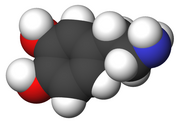Author: Jon C. Horvitz
Journal: Behavioural Brain Research
Year: 2002


Year: 2002


- Overview
- Traditional assumption: REWARD STIMULI are unique in producing a PHASIC dopamine (DA) response; other stimuli produce much more gradual (necessarily TONIC?) DA responses.
- Not assumed in this article
- Forebrain DA activity signals neither the "unpleasantness nor the pleasantness of the event" that elicited it.
- KEY IDEA: "Activation of substantia nigra (SN) and ventral tegmental area (VTA) DA neurons, and consequent release of nigrostriatal and mesolimbic DA to dorsal and ventral striatal target regions, modulates the processing of concurrent glutamate (Glu) inputs. [This] occurs under conditions of unexpected environmental change."
- Main question: How does DA transmission in the dorsal and ventral striatum influence behavior?
- What biological/environmental conditions lead to elevated DA activity?
- What information is carried by Glu inputs to striatal neurons?
- How are these Glu inputs modulated by DA activity?
- What is the ventral striatum?
- Nucleus accumbens
- Caudate-putamen
- Olfactory tubercle
- Here the ventral striatum means nucleus accumbens.
- Instead of thinking of DA as a 'chemical code' for reward, here it is argued that "environmentally elicited elevations in mesolimbic and nigrostriatal DA activity gate the input of reward signals to the striatum, just as they do for sensorimotor signals [...]"
- Such reward signals are likely to originate in orbitofrontal cortex and basolateral amygdala.
- What this means is that DA 'informs' striatal cells that an unexpected, important event has occurred.
- DA neurons respond to salient unexpected events
- It is unlikely that heightened attentional states are associated with a phasic DA response, because attentional systems would likely be recruited by both the presence of an unexpected event and the absence of an expected event. DA neurons increase activity only to the former, while they are inhibited by the latter.
- Time Course
- Very rapid onset
- Phasic activation increase in approximately 50-100 ms after stimulus onset
- It can't only be REWARD prediction error because of evidence showing that DA in prefrontal cortex (PFC) and nucleus accumbens (NA) is elevated under appetitive and aversive conditions.
- Primary Aim: "[P]rovide a framework that accounts both for the promiscuous DA response to salient events and for the large body of evidence showing that DA disruptions attentuate the impact of rewards (and punishers) on several aspects of behavior and learning."
- Important: DA may be considered a gatekeeper of glutamatergic information flow to the striatum.
- DA selectively promotes the processing of strong glutamate inputs to the striatum
- It turns out that DA acting at the D1 receptor increases the activity of glutamate at NMDA receptor sites. D2 however, does the opposite and reduces activity of glutamate at non-NMDA receptor sites.
- DA activity gates the throughput of sensorimotor and incentive motivational inputs to the striatum
- Striatal neurons receive inputs from a wide variety of 'types' of neurons. For example, the caudate, putamen, and ventral striatum contain neurons that respond to arm movements but only when the animal expects to receive a food reward following the movement. Conversely, very little activity is seen if a sound is expected to follow the movement.
- Striatal neurons respond to very abstract types of information.
- Ah, logic is so beautiful: [Individual striatal neurons] ... appear to be capable of representing the conjunction of two conditions[!]
- Striatal neurons are the
(and CONDITIONS ...)Lisp function! - What happens when nigrostriatal DA transmission is reduced?
- Not surprisingly, input signals are less likely to produce a response.
- Interestingly, when DA is depleted the striatal cell response is diminished but only in background activity NOT phasic activity. When DA is increased the phasic response is stronger than baseline and the background activity is actually reduced!
- There's evidence that suggests that DA modulates both the striatal response to current glutamate inputs and log-term changes in synaptic strength of these inputs.
- Striatal plasticity: stimulus-response learning, salience assignment to synaptic inputs, and/or stimulus-response-outcome chunking
- Schultz thinks that DA signals provide the 'difference' between reward occurrence and reward prediction. "The phasic DA response increases the synaptic strength betwee ncurrently ative striatal input and output elements, increasing the future likelihood that the current set of corticostriatal inputs (reward) will activate striatal outputs (motor responses)." The problem with this hypothesis is that if DA additionally responds to aversive events then modulation of behavior via this mechanism would mean that behavioral responses leading to aversive outcomes would be increased in number. So, says JH, DA's primary function will not likely be one involving the strengthening of stimulus-response (S-R) connections.
- So what does DA actually do then?
- Well, maybe strengthening of corticostriatal inputs via DA serves to increase the future salience of an event (or series of events).
- According to JCH this implies that additional processing of information is performed later in more specialized regions of basal ganglia. This would then imply that something downstream of the striatum is what is determining the reward value of a stimulus; it isn't indicated by the phasic DA response. He proposes frontal regions as the area that performs response selection.
- It's an indicator for salient environmental change
- Biologically this means that, due to the processes mentioned earlier, this change will cause an increase in "glutamate signal-to-noise ratios within dorsal and ventral striatal target sites"
- Thoughts and Questions
- What does it mean when 'a representation converges' onto a neuron?
- How do non-physical things (representations) converge onto physical things (neurons)?









